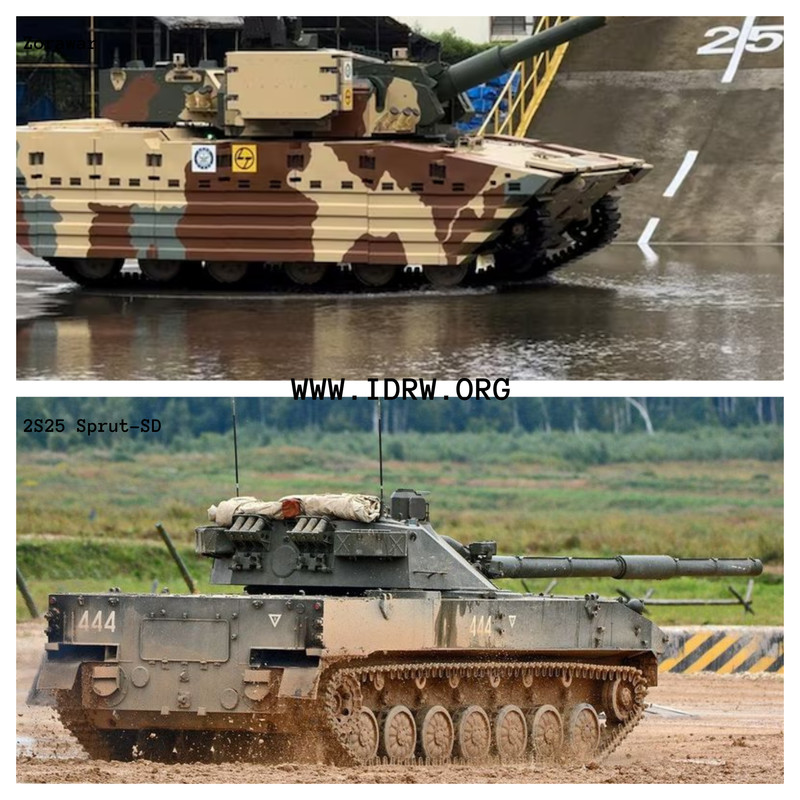SOURCE: AFI


Indian Army’s Light Tank Requirements will see faceoff between DRDO-L&T developed Zorawar Light Tank and AWEIL proposed Russian 2S25 Sprut-SD. This article compares two prominent light tanks: the Indian Zorawar and the Russian 2S25 Sprut-SD. Both of these platforms embody the fusion of mobility and firepower, but they cater to different operational needs and strategic doctrines.
Zorawar Light Tank Developed by India’s Defence Research and Development Organisation (DRDO), addresses the specific needs of the Indian Army, particularly in high-altitude regions like Ladakh and Arunachal Pradesh. The tank is named after Zorawar Singh, a legendary military general known for his campaigns in the Himalayas, reflecting its intended use in mountainous terrain. The Zorawar is part of India’s strategy to counter potential threats along its northern borders, especially from China.
The 2S25 Sprut-SD, developed by the Volgograd Tractor Plant, is a Russian amphibious light tank that combines the firepower of a main battle tank with the mobility of an airborne combat vehicle. Introduced in the early 2000s, it was designed primarily for the Russian Airborne Forces (VDV) and marine infantry. The Sprut-SD is intended for rapid deployment, capable of being air-dropped or amphibiously transported into combat zones.
The Zorawar tank is designed for high-altitude warfare, where lightweight construction and superior mobility are crucial. It is expected to be highly maneuverable, with the ability to traverse difficult terrain such as mountains and valleys. The tank is reportedly equipped with a high-power-to-weight ratio engine, enabling it to perform well in the challenging environments of the Himalayas.
The Sprut-SD is exceptionally mobile, with a hydropneumatic suspension that provides a smooth ride over rough terrain. It is also amphibious, capable of crossing water obstacles without preparation. The tank can be air-dropped from cargo aircraft like the Il-76, making it suitable for rapid deployment. Its mobility is enhanced by its relatively low weight and compact size, making it a versatile asset in diverse combat scenarios.
The Zorawar light tank is expected to be equipped with a 105mm rifled gun, capable of firing a variety of munitions, including high-explosive anti-tank (HEAT) and armor-piercing fin-stabilized discarding sabot (APFSDS) rounds. This armament allows the Zorawar to engage both armored targets and fortifications effectively. The tank may also feature modern fire control systems, including thermal imaging and laser rangefinders, enhancing its accuracy and lethality.
The 2S25 Sprut-SD is armed with a 125mm smoothbore gun, the same as used on Russia’s main battle tanks (MBTs) like the T-72 and T-90. This gives the Sprut-SD formidable firepower, capable of engaging and destroying MBTs. The gun can fire a wide range of munitions, including APFSDS, HEAT, and guided missiles. The Sprut-SD’s firepower is complemented by advanced fire control systems, making it a potent adversary in direct combat.
The Zorawar is likely to prioritize mobility over armor, but it is expected to feature modular armor that can be upgraded depending on the mission requirements. This modularity allows the tank to be adapted for different threat environments. Additionally, the Zorawar may be equipped with active protection systems (APS) to enhance its survivability against modern anti-tank guided missiles (ATGMs).
The Sprut-SD’s armor is relatively light, designed to protect against small arms fire and shell splinters rather than direct hits from MBTs. However, its amphibious capability and speed provide it with tactical protection, allowing it to avoid heavier engagements. The tank’s low profile and speed are its primary defensive measures, supplemented by basic smoke grenade launchers and potentially APS in upgraded versions.
The Zorawar is tailored for deployment in the mountainous regions of India, where traditional heavy tanks face significant mobility challenges. It is likely to be used in scenarios requiring quick strikes and defensive operations in rugged terrain. The tank’s design reflects India’s strategic focus on its northern borders, particularly in countering potential threats from China in areas like Ladakh.
The Sprut-SD is designed for rapid deployment by airborne and marine units. Its ability to be air-dropped or transported amphibiously makes it ideal for operations requiring swift force projection in various terrains, including coastal and riverine environments. The Sprut-SD fits within Russia’s broader military doctrine of using highly mobile, rapidly deployable forces to achieve strategic objectives quickly.
The Zorawar and 2S25 Sprut-SD light tanks represent two different approaches to modern light tank design, shaped by their respective countries’ strategic needs. The Zorawar is a specialized platform optimized for high-altitude operations, reflecting India’s focus on its northern borders. In contrast, the Sprut-SD is a versatile, rapidly deployable tank designed for airborne and amphibious operations, in line with Russia’s emphasis on quick, strategic mobility.